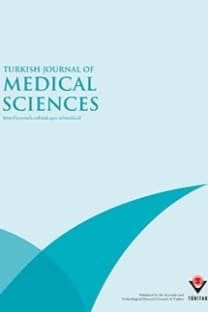Effects of whole-body vibration on plasma sclerostin level in healthy women
Key words: Sclerostin, cyclic mechanical loading, vibration, osteocyte, bone
Effects of whole-body vibration on plasma sclerostin level in healthy women
Key words: Sclerostin, cyclic mechanical loading, vibration, osteocyte, bone,
___
- Gaudio A, Pennisi P, Bratengeier C, Torrisi V, Lindner B, Mangiafico RA, Pulvirenti I, Hawa G, Tringali G, Fiore CE. Increased sclerostin serum levels associated with bone formation and resorption markers in patients with immobilization-induced bone loss. J Clin Endocrinol Metab 2010; 95: 2248–2253.
- Robling AG, Niziolek PJ, Baldridge LA, Condon KW, Allen MR, Alam I, Mantila SM, Gluhak-Heinrich J, Bellido TM, Harris SE et al. Mechanical stimulation of bone in vivo reduces osteocyte expression of Sost/sclerostin. J Biol Chem 2008; 283: 5866–5875.
- Lombardi G, Lanteri P, Colombini A, Mariotti M, Banfi G. Sclerostin concentrations in athletes: role of load and gender. J Biol Regul Homeost Agents 2012; 26: 157–163.
- Lin C, Jiang X, Dai Z, Guo X, Weng T, Wang J, Li Y, Feng G, Gao X, He L. Sclerostin mediates bone response to mechanical unloading through antagonizing Wnt/beta-catenin signaling. J Bone Miner Res 2009; 24: 1651–1661.
- Mödder UI, Hoey KA, Amin S, McCready LK, Achenbach SJ, Riggs BL, Melton LJ, Khosla S. Relation of age, gender, and bone mass to circulating sclerostin levels in women and men. J Bone Miner Res 2011; 26: 373–379.
- Moustafa A, Sugiyama T, Saxon LK, Zaman G, Sunters A, Armstrong VJ, Javaheri B, Lanyon LE, Price JS. The mouse fibula as a suitable bone for the study of functional adaptation to mechanical loading. Bone 2009; 44: 930–935.
- Suva LJ. Sclerostin and the unloading of bone. J Bone Miner Res 2009; 24: 1649–1650.
- Mirza FS, Padhi ID, Raisz LG, Lorenzo JA. Serum sclerostin levels negatively correlate with parathyroid hormone levels and free estrogen index in postmenopausal women. J Clin Endocrinol Metab 2010; 95: 1991–1997.
- Cullen DM, Smith RT, Akhter MP. Bone-loading response varies with strain magnitude and cycle number. J Appl Physiol 2001; 91: 1971–1976.
- Torcasio A, van Lenthe GH, Van Oosterwyck H. The importance of loading frequency, rate and vibration for enhancing bone adaptation and implant osseointegration. Eur Cell Mater 2008; 16: 56–68.
- Nikander R, Kannus P, Rantalainen T, Uusi-Rasi K, Heinonen A, Sievänen H. Cross-sectional geometry of weight-bearing tibia in female athletes subjected to different exercise loadings. Osteoporos Int 2010; 21: 1687–1694.
- Yang PF, Brüggemann GP, Rittweger. What do we currently know from in vivo bone strain measurements in humans? J Musculoskelet Neuronal Interact 2011; 11: 8–20.
- Kargotich S, Goodman C, Keast D, Morton AR. The influence of exercise-induced plasma volume changes on the interpretation of biochemical parameters used for monitoring exercise, training and sport. Sports Med 1998; 26: 101–117. Cardinale M, Soiza RL, Leiper JB, Gibson A, Primrose WR. Hormonal responses to a single session of whole-body vibration exercise in older individuals. Br J Sports Med 2010; 44: 284–288.
- Fricke O, Semler O, Land C, Beccard R, Thoma P, Schoenau E. Hormonal and metabolic responses to whole body vibration in healthy adults. Endocrinologist 2009; 19: 24–30.
- ISSN: 1300-0144
- Yayın Aralığı: 6
- Yayıncı: TÜBİTAK
Relation of age and sex with carotid intima media thickness in healthy children
Ali KOÇYİĞİT, Mustafa DOĞAN, İsmail YILMAZ, Murat ÇAĞLAR, Celile HATİPOĞLU, Figen KOÇYİĞİT, Duygu HEREK, Nevzat KARABULUT
Hülya ŞİMŞEK, Ünsal HAN, Binnur ÖNAL, Gülçin ŞİMŞEK
Detection of kinase amplifications in gastric adenocarcinomas
Muhsin ÖZDEMİR, Murat ÖZNUR, Evrim ÇİFTÇİ, Beyhan Durak ARAS, Hüseyin ASLAN, Hande SAYGILI, Kevser Setenay ÖNER, Serdar Mustafa ERKASAP, Ayşegül ÖZAKYOL, Özgül PAŞAOĞLU, Oğuz ÇİLİNGİR, Sevilhan ARTAN
Effects of whole-body vibration on plasma sclerostin level in healthy women*
Hakan EKMEKÇİ, Suat Hayri KÜÇÜK, Yunus KARAKOÇ2, Muharrem ÇİDEM, Şafak Sahir KARAMEHMETOĞLU, Kerem GÜN, İlhan KARACAN, Murat ULUDAĞ
Fereshteh EFTEKHAR, Fatemeh SALIMI
Refeeding hypophosphatemia: a potentially fatal danger in the intensive care unit
Ramazan COŞKUN, Kürşat GÜNDOĞAN, Süleyman BALDANE, Muhammet GÜVEN, Murat SUNGUR
Diastolic function of the right ventricle is impaired in experimental type 2 diabetic rat models
Ya MIAO, Wei ZHANG, Yuan ZHONG, Ming ZHONG, Xiao MA
Semih ARICI, Serkan KARAMAN, Serkan DOĞRU, Tuğba KARAMAN
Mete Kaan BOZKURT, Baykal TÜLEK, Banu BOZKURT, Nalan AKYÜREK, Mehmet ÖZ, Aysel KIYICI
